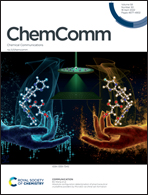Electrocatalytic reduction of nitrate by in situ generated cobalt nanoparticles†
Abstract
The cobalt pyridinophane complex [Co(HN4)Cl2]+ (HN4 = 3,7-diaza-1,5(2,6)-dipyridinacyclooctaphane) is converted under catalytic conditions to an electrode-adsorbed species. Aqueous Co2+ solutions similarly deposit a species under these conditions. Surface characterization reveals the formation of Co nanoparticles. These nanoparticles are active in the electrocatalytic redution of aqueous nitrate.



 Please wait while we load your content...
Please wait while we load your content...